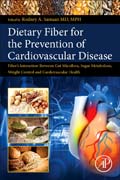
Dietary Fiber for the Prevention of Cardiovascular Disease: Fibers Interaction between Gut Micoflora, Sugar Metabolism, Weight Control and Cardiovascular Health
Samaan, Rodney A.
Dietary Fiber for the Prevention of Cardiovascular Disease: Fiber's Interaction between Gut Micoflora, Sugar Metabolism, Weight Control and Cardiovascular Health compiles the most up-to-date research discoveries to provide a timely and scientific rationale for the significant impact of a fiber rich diet for the prevention of heart disease. By focusing on the science behind how fiber, both soluble and insoluble can lead to lower rates of heart disease, this important reference will educate researchers, cardiologists, medical providers and students on how to improve patients' hearts via a fiber rich diet. Coverage includes the known mechanisms of how fiber works to reduce insulin resistance, control weight, reduce cholesterol by binding with bile, maintain stable glucose levels and influence gut microflora. Explains how fiber affects cardiovascular disease through the influence on insulin resistance, reduction of cholesterol, change in gut microflora and in weight controlProvides thorough coverage of the effect of fiber on arrhythmias and valvular abnormalitiesIncludes information on the indirect relationship between constipation and heart disease INDICE: 1. Why fiber matters? This chapter will introduce the argument that a diet high in fiber can reduce heart disease, maintain normal body weight, and reduce the risk of diabetes 2. The mechanism of fiber's effects on insulin resistance 3. The interaction between insoluble and soluble fiber 4. The influence of Fiber on Gut Microflora: Butyrate as a link between dietary fiber and cardiovascular health 5. The relationship between probiotics and fiber consumption and cardiovascular health 6. Dietary fiber for prevention of vascular disease in diabetes 7. Sources of fiber 8. Conclusion: how my own patients have benefited from a high fiber diet, in their own words
- ISBN: 978-0-12-805130-6
- Editorial: Academic Press
- Encuadernacion: Rústica
- Páginas: 180
- Fecha Publicación: 01/08/2017
- Nº Volúmenes: 1
- Idioma: Inglés
